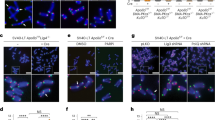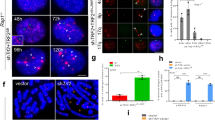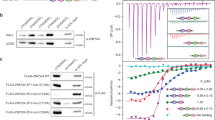Abstract
Mammalian telomeres repress DNA-damage activation at natural chromosome ends by recruiting specific inhibitors of the DNA-damage machinery that form a protective complex termed shelterin. Within this complex, TRF2 (also known as TERF2) has a crucial role in end protection through the suppression of ATM activation and the formation of end-to-end chromosome fusions1,2. Here we address the molecular properties of TRF2 that are both necessary and sufficient to protect chromosome ends in mouse embryonic fibroblasts. Our data support a two-step mechanism for TRF2-mediated end protection. First, the dimerization domain of TRF2 is required to inhibit ATM activation, the key initial step involved in the activation of a DNA-damage response (DDR). Next, TRF2 independently suppresses the propagation of DNA-damage signalling downstream of ATM activation. This novel modulation of the DDR at telomeres occurs at the level of the E3 ubiquitin ligase RNF168 (ref. 3). Inhibition of RNF168 at telomeres involves the deubiquitinating enzyme BRCC3 and the ubiquitin ligase UBR5, and is sufficient to suppress chromosome end-to-end fusions. This two-step mechanism for TRF2-mediated end protection helps to explain the apparent paradox of frequent localization of DDR proteins at functional telomeres without concurrent induction of detrimental DNA-repair activities.
This is a preview of subscription content, access via your institution
Access options
Subscribe to this journal
Receive 51 print issues and online access
$199.00 per year
only $3.90 per issue
Buy this article
- Purchase on Springer Link
- Instant access to full article PDF
Prices may be subject to local taxes which are calculated during checkout




Similar content being viewed by others
References
Celli, G. B. & de Lange, T. DNA processing is not required for ATM-mediated telomere damage response after TRF2 deletion. Nature Cell Biol. 7, 712–718 (2005)
Denchi, E. L. & de Lange, T. Protection of telomeres through independent control of ATM and ATR by TRF2 and POT1. Nature 448, 1068–1071 (2007)
Stewart, G. S. et al. The RIDDLE syndrome protein mediates a ubiquitin-dependent signaling cascade at sites of DNA damage. Cell 136, 420–434 (2009)
de Lange, T. Protection of mammalian telomeres. Oncogene 21, 532–540 (2002)
di Fagagna, F. D. et al. A DNA damage checkpoint response in telomere-initiated senescence. Nature 426, 194–198 (2003)
Takai, H., Smogorzewska, A. & de Lange, T. DNA damage foci at dysfunctional telomeres. Curr. Biol. 13, 1549–1556 (2003)
van Steensel, B., Smogorzewska, A. & de Lange, T. TRF2 protects human telomeres from end-to-end fusions. Cell 92, 401–413 (1998)
Smogorzewska, A., Karlseder, J., Holtgreve-Grez, H., Jauch, A. & de Lange, T. DNA ligase IV-dependent NHEJ of deprotected mammalian telomeres in G1 and G2. Curr. Biol. 12, 1635–1644 (2002)
Broccoli, D., Smogorzewska, A., Chong, L. & deLange, T. Human telomeres contain two distinct Myb-related proteins, TRF1 and TRF2. Nature Genet. 17, 231–235 (1997)
Difilippantonio, S. et al. 53BP1 facilitates long-range DNA end-joining during V(D)J recombination. Nature 456, 529–533 (2008)
Dimitrova, N., Chen, Y. C., Spector, D. L. & de Lange, T. 53BP1 promotes non-homologous end joining of telomeres by increasing chromatin mobility. Nature 456, 524–528 (2008)
Lukas, J., Lukas, C. & Bartek, J. More than just a focus: the chromatin response to DNA damage and its role in genome integrity maintenance. Nature Cell Biol. 13, 1161–1169 (2011)
Doil, C. et al. RNF168 binds and amplifies ubiquitin conjugates on damaged chromosomes to allow accumulation of repair proteins. Cell 136, 435–446 (2009)
Sfeir, A. et al. Mammalian telomeres resemble fragile sites and require TRF1 for efficient replication. Cell 138, 90–103 (2009)
Sarthy, J., Bae, N. S., Scrafford, J. & Baumann, P. Human RAP1 inhibits non-homologous end joining at telomeres. EMBO J. 28, 3390–3399 (2009)
Takai, K. K., Kibe, T., Donigian, J. R., Frescas, D. & de Lange, T. Telomere protection by TPP1/POT1 requires tethering to TIN2. Mol. Cell 44, 647–659 (2011)
Sfeir, A., Kabir, S., van Overbeek, M., Celli, G. B. & de Lange, T. Loss of Rap1 induces telomere recombination in the absence of NHEJ or a DNA damage signal. Science 327, 1657–1661 (2010)
Chen, Y. et al. A shared docking motif in TRF1 and TRF2 used for differential recruitment of telomeric proteins. Science 319, 1092–1096 (2008)
Nakada, S. et al. Non-canonical inhibition of DNA damage-dependent ubiquitination by OTUB1. Nature 466, 941–946 (2010)
Shao, G. et al. The Rap80-BRCC36 de-ubiquitinating enzyme complex antagonizes RNF8-Ubc13-dependent ubiquitination events at DNA double strand breaks. Proc. Natl Acad. Sci. USA 106, 3166–3171 (2009)
Wang, Y. et al. BASC, a super complex of BRCA1-associated proteins involved in the recognition and repair of aberrant DNA structures. Genes Dev. 14, 927–939 (2000)
Chen, L., Nievera, C. J., Lee, A. Y. & Wu, X. Cell cycle-dependent complex formation of BRCA1.CtIP.MRN is important for DNA double-strand break repair. J. Biol. Chem. 283, 7713–7720 (2008)
Zhu, X. D., Kuster, B., Mann, M., Petrini, J. H. & de Lange, T. Cell-cycle-regulated association of RAD50/MRE11/NBS1 with TRF2 and human telomeres. Nature Genet. 25, 347–352 (2000)
Gudjonsson, T. et al. TRIP12 and UBR5 suppress spreading of chromatin ubiquitylation at damaged chromosomes. Cell 150, 697–709 (2012)
Griffith, J. D. et al. Mammalian telomeres end in a large duplex loop. Cell 97, 503–514 (1999)
Verdun, R. E., Crabbe, L., Haggblom, C. & Karlseder, J. Functional human telomeres are recognized as DNA damage in G2 of the cell cycle. Mol. Cell 20, 551–561 (2005)
Carneiro, T. et al. Telomeres avoid end detection by severing the checkpoint signal transduction pathway. Nature 467, 228–232 (2010)
Al-Wahiby, S. & Slijepcevic, P. Chromosomal aberrations involving telomeres in BRCA1 deficient human and mouse cell lines. Cytogenet. Genome Res. 109, 491–496 (2005)
McPherson, J. P. et al. A role for Brca1 in chromosome end maintenance. Hum. Mol. Genet. 15, 831–838 (2006)
Acknowledgements
We thank T. de Lange, M. D. Weitzman, D. Durucher, X. Yu and X. Wu for providing reagents. We are grateful to A. Sfeir, T. Stracker, K. Miller and C. Attwooll for critical reading of the manuscript. This work was supported by a Pew Scholars Award (E.L.D.), the Novartis Advanced Discovery Institute (E.L.D.), National Institutes of Health AG038677 (E.L.D.), National Center for Research Resources (5P41RR011823-17) (J.R.Y.) and National Institute of General Medical Sciences (8 P41 GM103533-17) (J.R.Y.).
Author information
Authors and Affiliations
Contributions
E.L.D. and K.O. conceived the experimental design. K.O., C.B., I.O. and E.L.D. performed the experiments and analysed the data. J.K.D. and J.R.Y. performed the mass spectrometry analysis. E.L.D. wrote the manuscript.
Corresponding author
Ethics declarations
Competing interests
The authors declare no competing financial interests.
Supplementary information
Supplementary Information
This file contains Supplementary Figures 1-18, Supplementary Tables 1-2 and the legend for Supplementary Table 3 (see separate excel file). (PDF 11399 kb)
Supplementary Tables
This file contains Supplementary Table 3 (see Supplementary Information file for legend). (XLS 86 kb)
Rights and permissions
About this article
Cite this article
Okamoto, K., Bartocci, C., Ouzounov, I. et al. A two-step mechanism for TRF2-mediated chromosome-end protection. Nature 494, 502–505 (2013). https://doi.org/10.1038/nature11873
Received:
Accepted:
Published:
Issue Date:
DOI: https://doi.org/10.1038/nature11873
This article is cited by
-
Deubiquitinase BRCC3 promotes the migration, invasion and EMT progression of colon adenocarcinoma by stabilizing MET expression
Genes & Genomics (2024)
-
Non-canonical telomere protection role of FOXO3a of human skeletal muscle cells regulated by the TRF2-redox axis
Communications Biology (2023)
-
All roads lead to MRN regulation at telomeres: different paths to one solution
Nature Structural & Molecular Biology (2023)
-
The neuro-protective role of telomerase via TERT/TERF-2 in the acute phase of spinal cord injury
European Spine Journal (2023)
-
Zbp1 gene: a modulator of multiple aging hallmarks as potential therapeutic target for age-related diseases
Biogerontology (2023)
Comments
By submitting a comment you agree to abide by our Terms and Community Guidelines. If you find something abusive or that does not comply with our terms or guidelines please flag it as inappropriate.



